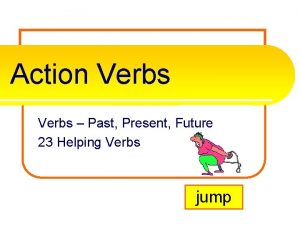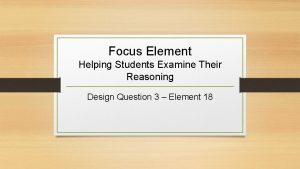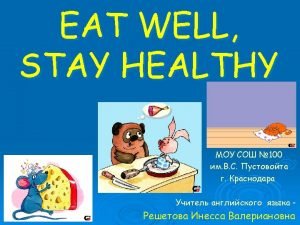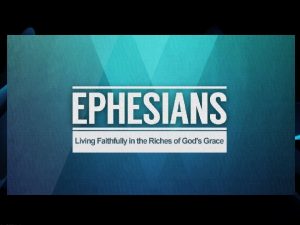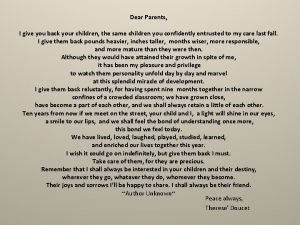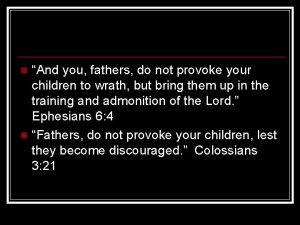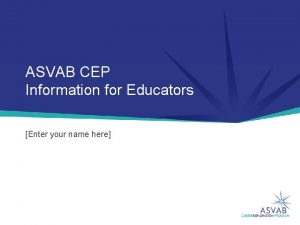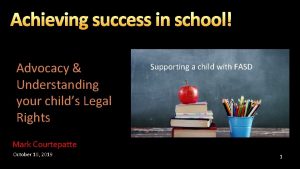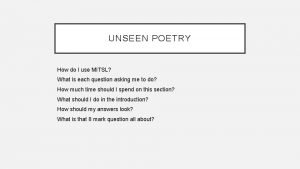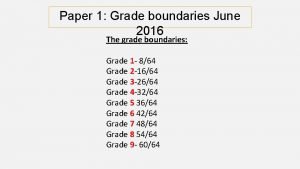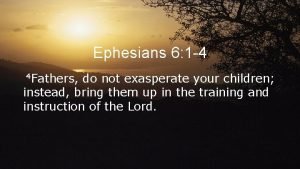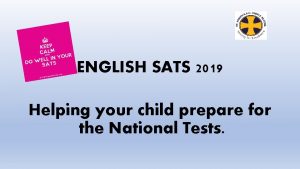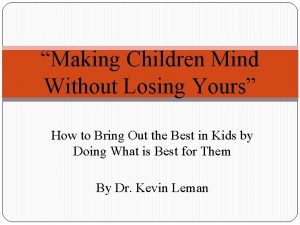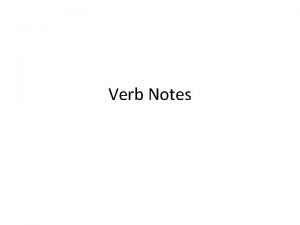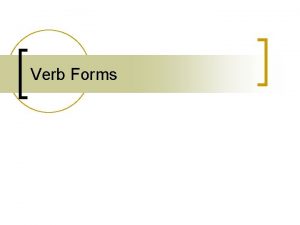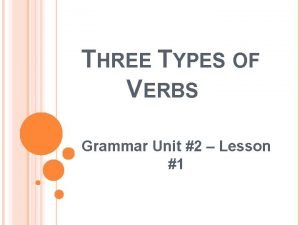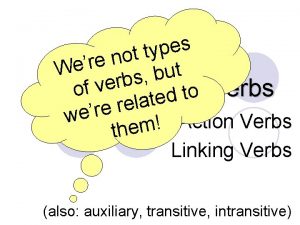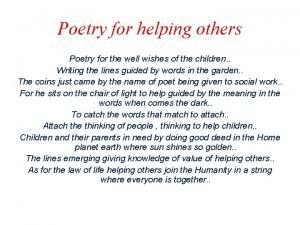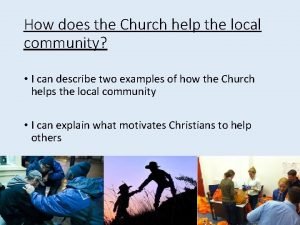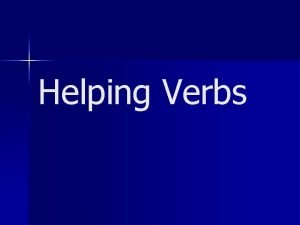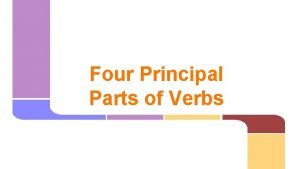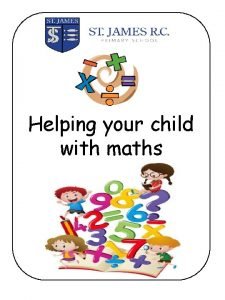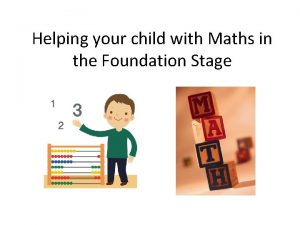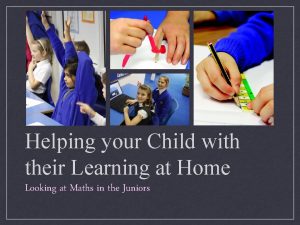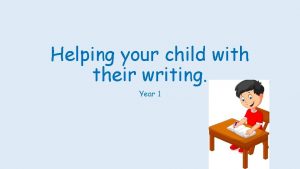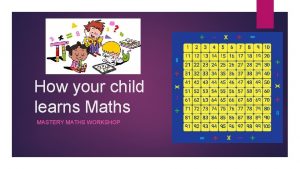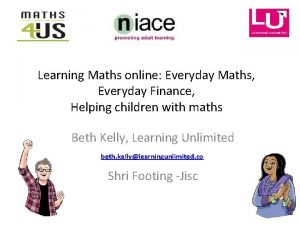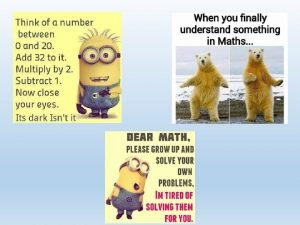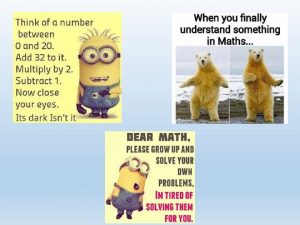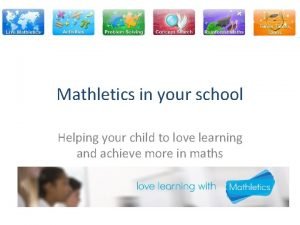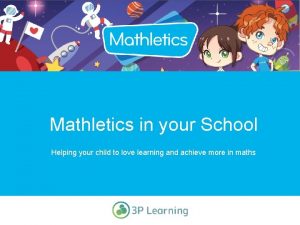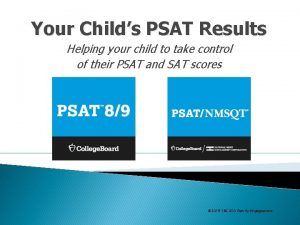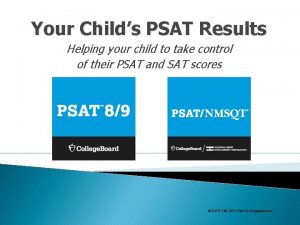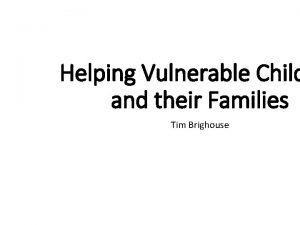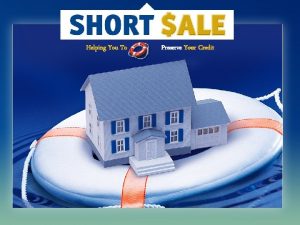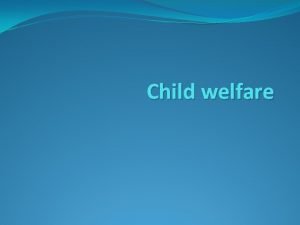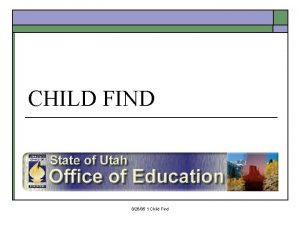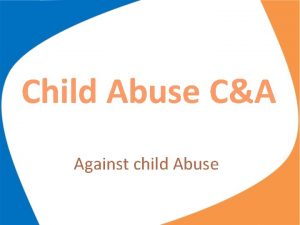Maths Helping Your Child with Their Maths at
































- Slides: 32

Maths Helping Your Child with Their Maths at Home

Maths in the Infants �Progression in number work �Methods we use for the operations �Other maths in the infants �How to help your child at home

Counting using Objects • Count up to 10 and beyond • Relate the numbers to objects • Counting systematically

Counting using Objects • The first step in children’s number work is counting up to 10 and beyond. • Children then need to understand how to relate the numbers to objects. • They need to come up with a system so that they do not miss objects. • We encourage children to put the objects in a line and start from one side. • We also encourage them to touch the objects as they count them.

Relating amounts to number Children then need to be able to recognise the numbers that they are using to count. Relating the numbers to a numeral is quite a big jump for some children. The more familiar they are with the numerals, the quicker they will learn them. = 5 = 6


Recognising and Writing numbers This is how we write numbers in our school. The earlier children practise writing numbers the right way round the less likely they are to get into the habit of writing them incorrectly. In early number formation 2 and 5 are easily confused. 2 3 6 7 8 5 0

Ordering numbers 2 5 3 2 3 5 Key Words: • More than • Less / fewer than

Ordering numbers 9 3 2 7 2 2 3 7 9 2 Key Words: • More than • Less / fewer than

Place Value • A child having a deep understanding of place value is integral to their progression in maths. • Once they are familiar with numbers over 10 we work on identifying the ‘tens digit’ and the ‘ones’ in each number. • It is important that the children know the value of each digit. • In this example 13 is made up of ‘ 1 ten’ and ‘ 3 ones’ • Place Value cards are one resource we use to support this concept. 0 3 0 3

Place Value In school we also use tens rods and ones cubes to help children understand that 10 ones is the same as one set of 10. We also use numcon. = 10 = 1 = 36 You could support this idea at home when they are counting numbers greater than 10, by grouping objects together in tens as they count up.

Place Value The children need to be able to locate given numbers in a hundred square by identifying the tens digit of that number first then finding the corresponding row. They should also know that the higher the tens digit, the lower the row is located in the hundred square. Key Words: • tens /ones digit • teens number

Number Facts �A ‘number bond’ is two numbers which are added together to make another number. 10 = 8 + 2 �Use number bonds to mentally calculate e. g. 56 + _ = 60 �Another vital mental maths skill is doubling numbers up to 5 /10 / 20. This is first taught using hands and then pictures. �After this, the children will then learn the inverse of doubling: halving.

Addition and Subtraction Using Objects � We often get asked what objects children should use to help them add up at home. . . ANYTHING!!! � For addition, ask children to count out two groups of objects, combine them and see how much there is ‘altogether’. � For subtraction, encourage children to count out the larger group then ‘take away’ the smaller number and see ‘how many are left’. � We use lots of different words for addition and subtraction, and we do not introduce the + and – symbols until children are very confident with the operations.

Using a number line to add • Children can start to use a number line for addition and subtraction when they start to have a better understanding of abstract number. • It is important that they relate addition to ‘counting on’ and subtraction to ‘counting back’ on the number lines. • They must understand that, with addition, the total amount will be the largest and, when taking away, the result will be smaller than the initial amount. 1 2 3 4 5 6 7 8 9 10 11 12 13 14 15 16 17 18 19 20 21 22 23 24 12 + 8 =

Addition in year two � In year two, the children will use their knowledge of place value to help with calculating addition problems. � Here is an example: 12 + 13 = � First they will partition the tens and calculate. � Then they partition the units and calculate. � Finally the totals are recombined to find the final answer. TU 12 + 13 = 25 10 2 10 3 10 + 10 = 20 2 + 3 = 5

Using a number line to subtract 20 – 8 = When subtracting, children will need to understand that they can start with the largest number and count back. 1 2 3 4 5 6 7 8 9 10 11 12 13 14 15 16 17 18 19 20 21 22 23 24 We also learn to ‘find the difference’ to solve subtraction number sentences, where they start with the lower number. 1 2 3 4 5 6 7 8 9 10 11 12 13 14 15 16 17 18 19 20 21 22 23 24 12 jumps

Multiplication and Division We do not use the symbols for multiplication or division until children are confident with the concept of ‘lots of’ as repeated addition and division as ‘sharing’. 4 lots of 2 2 + 2 + 2 = 8 Key Words: • Lots of. . . • Sets of … • Groups of … • Shared between… 6 shared by 3

New National Curriculum The new National Curriculum states that, by the end of year two, pupils should know how to: üRecall and use multiplication and division facts for the 2, 5 and 10 times tables.

Word problems � Once the children are confident with using the methods of each operation we use word problems so they can apply their skills to ‘real life’ situations. The problem: • When the children are familiar with more than one operation (e. g. addition and subtraction), an important part of word problems is deciding what operation to use. Bob had 24 sweets. He ate 6 sweets. How many sweets does Bob have left? What do I need to do? - (take away) Write the number sentence and solve it: 24 – 6 = My answer:

Other Maths in The Infants Patterns Sorting

Other Maths in The Infants 2 D Shape 3 D Shape Key Words: • Faces • Edges • Vertices Key Words: • Corners • Sides • Straight • Curved

Other Maths in The Infants Measuring Key Words: • Estimate • Length – long, tall, wide thick thin. . . not ‘big’ • Mass – weigh, light, heavy • Capacity – full, empty

Other Maths in The Infants Time • Sequencing events. • Times of day, e. g. morning, afternoon, • Days, then months, in order. • Analogue & digital clock

Money �Need to recognise coins and know the value of each. �When counting small amounts, tap the coin the correct amount of times. �Making totals, first with 1 ps, then using other coins. �Adding and subtracting amounts. �Finding change. The more opportunity your child has to use money, the easier they will find maths related to it.

Language in Maths �Please see the vocabulary lists below, to show words used in maths lessons in the infants. �We encourage children to verbalise their understanding and explain how they have got their answer. �Talking about maths reinforces the children’s understanding and allows us to find any misconceptions they may have.

Key Vocabulary in Mathematics � Number Operations There are four operations, sometimes called the four rules of number and each is represented by a sign. + Addition - Subtraction x Multiplication ÷ Division Add Plus Count on Total Altogether More of Sum of Take away Count back Less Difference of Subtract Fewer Lots of Sets of Groups of Product Times Share Divide Split between Groups of

Key Vocabulary in Mathematics Place Value Using number single digit (0 – 9) teens number (11 – 19) hundreds digit 342 tens digit 342 ones digit 342 Sequence (number pattern) Number bond (two numbers that together make another number) Double / Halve Inverse (opposite of, e. g. + is inverse of -) Number sentence (previously called a sum but please refer to is as number sentence) Ordering Greater / more than Fewer / less than Estimate OR a sensible guess

Key Vocabulary in Mathematics �Shape 2 D Shape 3 D Shape Sides Corners Angles Straight Curved Faces Vertices Edges Flat

Supporting your children. These are some of the ways in which you can support your children at home: ü Hearing your child read 2 -3 times a week and signing the diary. Positive and constructive comments welcome. ü Use the new reading diaries to practise phonics, spellings and unfamiliar vocabulary. ü Help with weekly homework tasks and have high expectations of presentation and effort. These will include phonics, EPGS and maths tasks.

Thank you for coming. Any questions? Please see our school website for a copy of this handout. http: //www. huttonallsaints. co. uk/

Useful websites for maths games to play at home: EYFS: • http: //www. oxfordowl. co. uk/welcome/for-home/maths-owl/maths • http: //www. ictgames. com/primary. Strategy 1. html • http: //www. iboard. co. uk/activities/subject/maths • http: //www. topmarks. co. uk/maths-games/3 -5 -years/counting • http: //www. crickweb. co. uk/Early-Years. html (maths and literacy) • http: //www. teachingideas. co. uk/earlyyears/contents_maths. htm • http: //www. comberps. newtownards. ni. sch. uk/maths_games_for_early_years. htm • http: //www. bbc. co. uk/schools/websites/eyfs/ • http: //www. earlylearninghq. org. uk/numeracy/ Year one and two: http: //www. topmarks. co. uk/ http: //www. mathschamps. co. uk/#home http: //www. primarygames. com/ http: //mathszone. co. uk/ http: //www. mathplayground. com/ http: //www. bbc. co. uk/bitesize/ks 1/maths/
 Helping verbs past present future
Helping verbs past present future Helping students examine their reasoning marzano
Helping students examine their reasoning marzano Helping students examine their reasoning
Helping students examine their reasoning My mother set c
My mother set c 이진트리 복사 순회
이진트리 복사 순회 Give us your hungry your tired your poor
Give us your hungry your tired your poor Shakespeare romeo and juliet prologue in modern english
Shakespeare romeo and juliet prologue in modern english Do not provoke your child to anger
Do not provoke your child to anger I give you back your child letter
I give you back your child letter Parents provoke not your child
Parents provoke not your child Your child's success or lack of success
Your child's success or lack of success Occufind
Occufind Your child's success or lack of success
Your child's success or lack of success Nina’s favorite subject is science
Nina’s favorite subject is science Through your child's eyes
Through your child's eyes Woe unto you when your king is a child
Woe unto you when your king is a child Dear parents i give you back your child poem
Dear parents i give you back your child poem To a daughter leaving home and poem for my sister
To a daughter leaving home and poem for my sister Mitsl
Mitsl Do not embitter your child
Do not embitter your child English sats 2019
English sats 2019 Oh okay
Oh okay Action linking helping verbs
Action linking helping verbs Chad b swim helping verbs
Chad b swim helping verbs Verb in n
Verb in n Types of verb
Types of verb Linking verb and auxiliary verb
Linking verb and auxiliary verb Action verb poem
Action verb poem Past participle and past perfect
Past participle and past perfect Poems about helping others in need
Poems about helping others in need How does the church help the community
How does the church help the community Supporting verb
Supporting verb Principal parts of verbs examples
Principal parts of verbs examples
